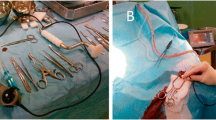Abstract
Background
Subdural (SDE) and epidural empyema (EDE) are life-threatening intracranial infections. They require immediate diagnosis and treatment. However, in some cases, magnet resonance imaging (MRI) is not able to contribute to diagnosis; therefore, surgical exploration is indicated. Hollow screws used for decompression of chronic subdural haematoma (cSDH) are valuable tools for minimally invasive biopsy in awake patients when SDE and EDE are suspected.
Methods
Between 2006 and 2010, eight patients in our department underwent biopsy of a suspected SDE or EDE using hollow screws. In these cases, MRI or computed tomography (CT) were not able to provide sufficient diagnostic security to indicate primary craniotomy. Diagnostic and therapeutic efficacy was evaluated on preoperative and postoperative imaging. The focus was on qualitative parameters, such as contrast enhancement or impaired diffusion on diffusion-weighted images (DWI).
Results
The application of the hollow screw under local anaesthesia permitted an exact diagnosis in all cases. In one case, the suspected diagnosis of cSDH could be refuted by diagnostic puncture. In four cases of uncertain diagnosis, the application of the hollow screw revealed a cSDH. Seven of eight patients previously received neurosurgical treatment; three of those cases were SDE or EDE and four were cSDH. Cases of SDE and EDE needed further craniotomy after diagnostic puncture, whereas patients with cSDH were sufficiently treated by hollow screws.
Conclusions
Given their comparably wide diameter, hollow screws allow a sufficient sample size and, therefore, lead to precise diagnosis of SDE and EDE without significant operative risks or strains for the patient.

Similar content being viewed by others
References
Bannister G, Williams B, Smith S (1981) Treatment of subdural empyema. J Neurosurg 55:82–88
De Bonis P, Anile C, Pompucci A, Labonia M, Lucantoni C, Mangiola A (2009) Cranial and spinal subdural empyema. Br J Neurosurg 23:335–340
Emonds N, Hassler WE (1999) New device to treat chronic subdural hematoma—hollow screw. Neurol Res 21:77–78
Fanning NF, Laffan EE, Shroff MM (2006) Serial diffusion-weighted MRI correlates with clinical course and treatment response in children with intracranial pus collections. Pediatr Radiol 36:26–37
Farrell CJ, Hoh BL, Pisculli ML, Henson JW, Barker FG 2nd, Curry WT Jr (2008) Limitations of diffusion-weighted imaging in the diagnosis of postoperative infections. Neurosurgery 62:577–583, discussion 577–583
Feuerman T, Wackym PA, Gade GF, Dubrow T (1989) Craniotomy improves outcome in subdural empyema. Surg Neurol 32:105–110
Greenlee JE (2003) Subdural empyema. Curr Treat Options Neurol 5:13–22
Grossman RI (2000) Brain imaging. AJNR Am J Neuroradiol 21:9–18
Hughes DC, Raghavan A, Mordekar SR, Griffiths PD, Connolly DJ (2010) Role of imaging in the diagnosis of acute bacterial meningitis and its complications. Postgrad Med J 86:478–485
Illian CHP (2004) Das chronisch subdurale Hämatom: operative technik mit einer speziellen Hohlschraube. Aus dem Klinikum Duisburg Wedau Kliniken Klinik für Neurochirurgie. Medizinische Fakultät der Universität Duisburg-Essen, Duisburg-Essen
Kawano H, Yonemura K, Misumi Y, Hashimoto Y, Hirano T, Uchino M (2005) A case of interhemispheric subdural empyema with sinusitis diagnosed by diffusion-weighted MRI. Rinsho Shinkeigaku 45:449–452
Khan M, Griebel R (1984) Subdural empyema: a retrospective study of 15 patients. Can J Surg 27(283–285):288
Klein O, Freppel S, Schuhmacher H, Pinelli C, Auque J, Marchal JC (2006) Subdural empyema in children: therapeutic strategy. Five cases. Neurochirurgie 52:111–118
Krieg SM, Aldinger F, Stoffel M, Meyer B, Kreutzer J (2012) Minimally invasive decompression of chronic subdural haematomas using hollow screws: efficacy and safety in a consecutive series of 320 cases. Acta Neurochir (Wien) 154:699–705
Mat Nayan SA, Mohd Haspani MS, Abd Latiff AZ, Abdullah JM, Abdullah S (2009) Two surgical methods used in 90 patients with intracranial subdural empyema. J Clin Neurosci 16:1567–1571
Mishra AM, Gupta RK, Jaggi RS, Reddy JS, Jha DK, Husain N, Prasad KN, Behari S, Husain M (2004) Role of diffusion-weighted imaging and in vivo proton magnetic resonance spectroscopy in the differential diagnosis of ring-enhancing intracranial cystic mass lesions. J Comput Assist Tomogr 28:540–547
Narita E, Maruya J, Nishimaki K, Heianna J, Miyauchi T, Nakahata J, Kitahara H, Minakawa T (2009) Case of infected subdural hematoma diagnosed by diffusion-weighted imaging. Brain Nerve 61:319–323
Nathoo N, Nadvi SS, Gouws E, van Dellen JR (2001) Craniotomy improves outcomes for cranial subdural empyemas: computed tomography-era experience with 699 patients. Neurosurgery 49:872–877, discussion 877–878
Ouahes O, Kalamarides M, Redondo A, Berthelot JL, Bouali I, Rey A (1995) Subdural empyema. Apropos of 17 cases. Neurochirurgie 41:319–323
Reinges MH, Hasselberg I, Rohde V, Kuker W, Gilsbach JM (2000) Prospective analysis of bedside percutaneous subdural tapping for the treatment of chronic subdural haematoma in adults. J Neurol Neurosurg Psychiatry 69:40–47
Rohde V, Graf G, Hassler W (2002) Complications of burr-hole craniostomy and closed-system drainage for chronic subdural hematomas: a retrospective analysis of 376 patients. Neurosurg Rev 25:89–94
Silvera S, Oppenheim C, Touze E, Ducreux D, Page P, Domigo V, Mas JL, Roux FX, Fredy D, Meder JF (2005) Spontaneous intracerebral hematoma on diffusion-weighted images: influence of T2-shine-through and T2-blackout effects. AJNR Am J Neuroradiol 26:236–241
Tewari MK, Sharma RR, Shiv VK, Lad SD (2004) Spectrum of intracranial subdural empyemas in a series of 45 patients: current surgical options and outcome. Neurol India 52:346–349
Tsuchiya K, Osawa A, Katase S, Fujikawa A, Hachiya J, Aoki S (2003) Diffusion-weighted MRI of subdural and epidural empyemas. Neuroradiology 45:220–223
Acknowledgements
The study was completely financed by the Department of Neurosurgery, Klinikum rechts der Isar, Technical University Munich.
Conflicts of interest
None.
Author information
Authors and Affiliations
Corresponding author
Rights and permissions
About this article
Cite this article
Aldinger, F.A., Shiban, E., Gempt, J. et al. Hollow screws: a diagnostic tool for intracranial empyema. Acta Neurochir 155, 373–377 (2013). https://doi.org/10.1007/s00701-012-1581-0
Received:
Accepted:
Published:
Issue Date:
DOI: https://doi.org/10.1007/s00701-012-1581-0




